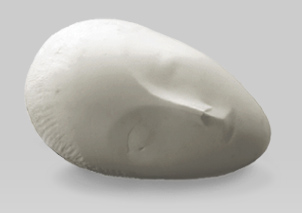|
|
Brancusi looked for universal qualities in the particular and understood that a part of the body could stand for the whole. Over time his pursuit of the torso theme—begun early in his career with Torso (1908)—resulted in the ideal form of 1922's Torso of a Young Girl (see Overview page). This work is hardly descriptive of the human body but instead establishes a dropletlike form, which may be seen as an interpretation of the body as vessel.
A similar transition can be detected in Brancusi's treatment of perhaps the most expressive feature of the human form, the head. In Sleeping Muse I (1909–10), the elegant pinching of the nose runs into the steeply arched brows, describing a form that provides a clear structure for the face. A further stage in this refinement is evident in Newborn II (1919–21), in which an angled plane suggests the screaming mouth that itself symbolizes the struggle of entering the world. Brancusi soon carried his stylization of natural forms to the point of pure abstraction, although he always found this term restrictive. Beginning of the World (ca. 1920) is the epitome of this new development. The simple, ovoid form of this work manages to embody universal aspirations, suggesting fertility and evoking ancient myths of cosmic origins, as confirmed by the title.
Contantin Brancusi, Sleeping Muse I, 1909–10. Marble, 6 3/4 x 10 7/8 x 8 3/8 inches. Hirshorn Museum and Sculpture Garden. Smithsonian Institution, Washington, D.C., Gift of Joseph H. Hirshorn, 1966. © 2004 Artists Rights Society (ARS), New York/ADAGP, Paris.
|
|

